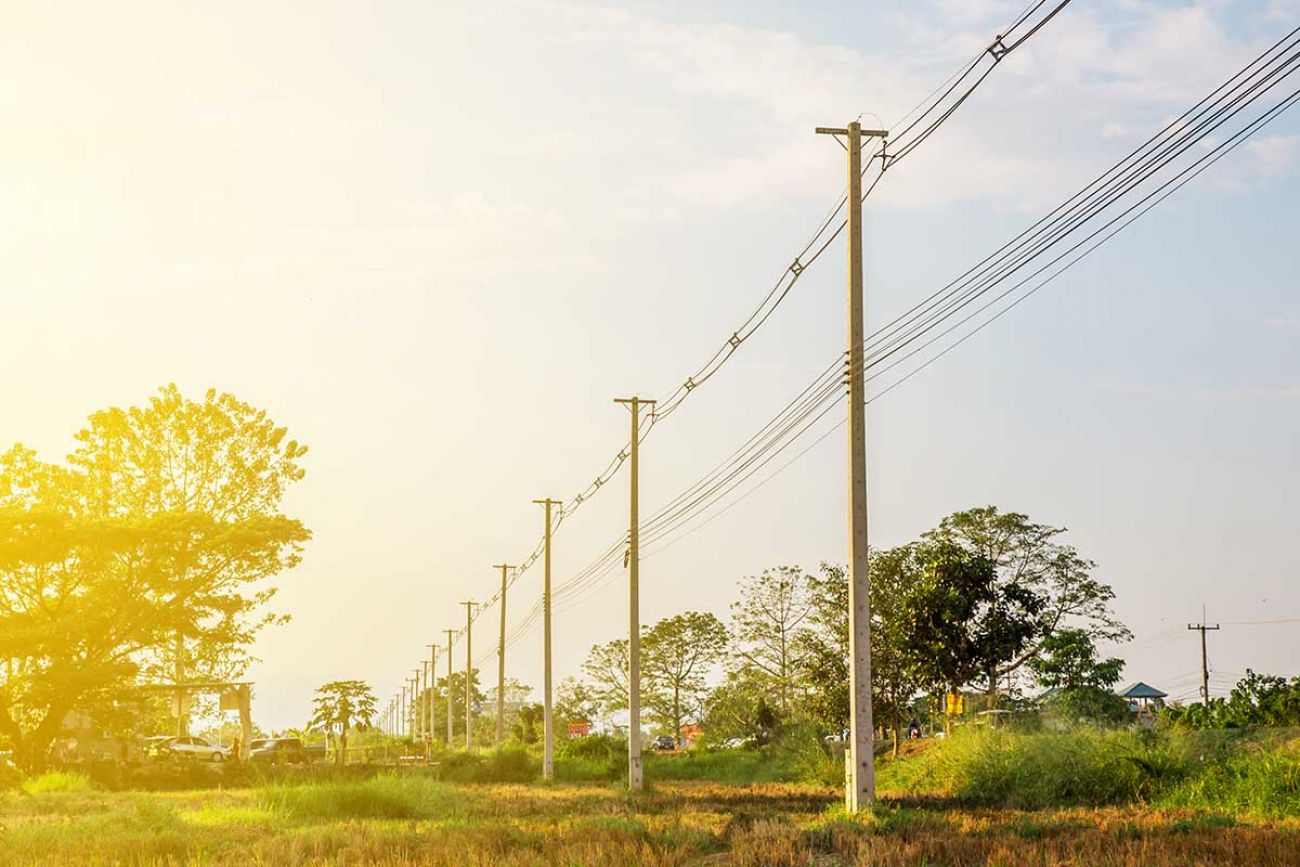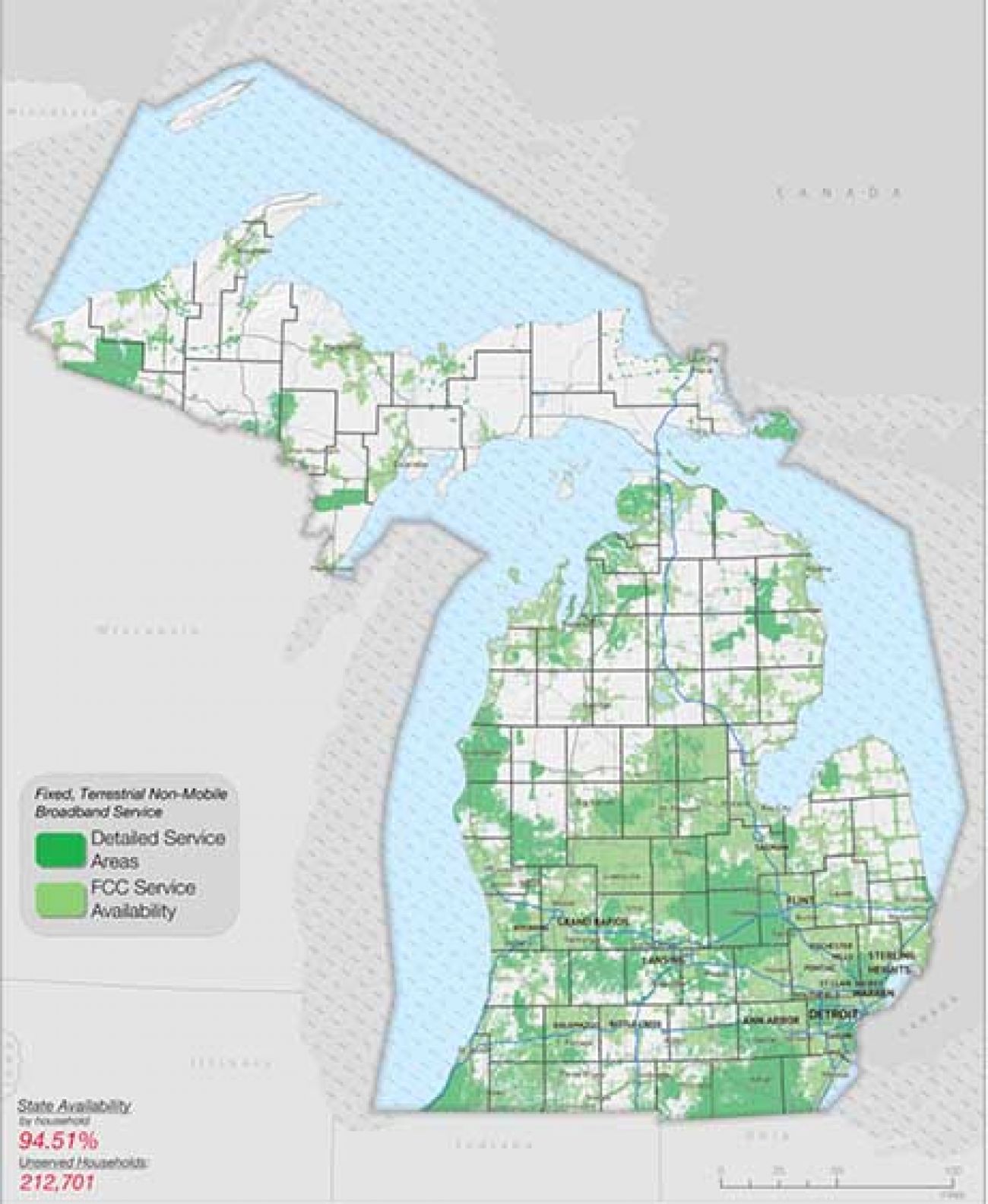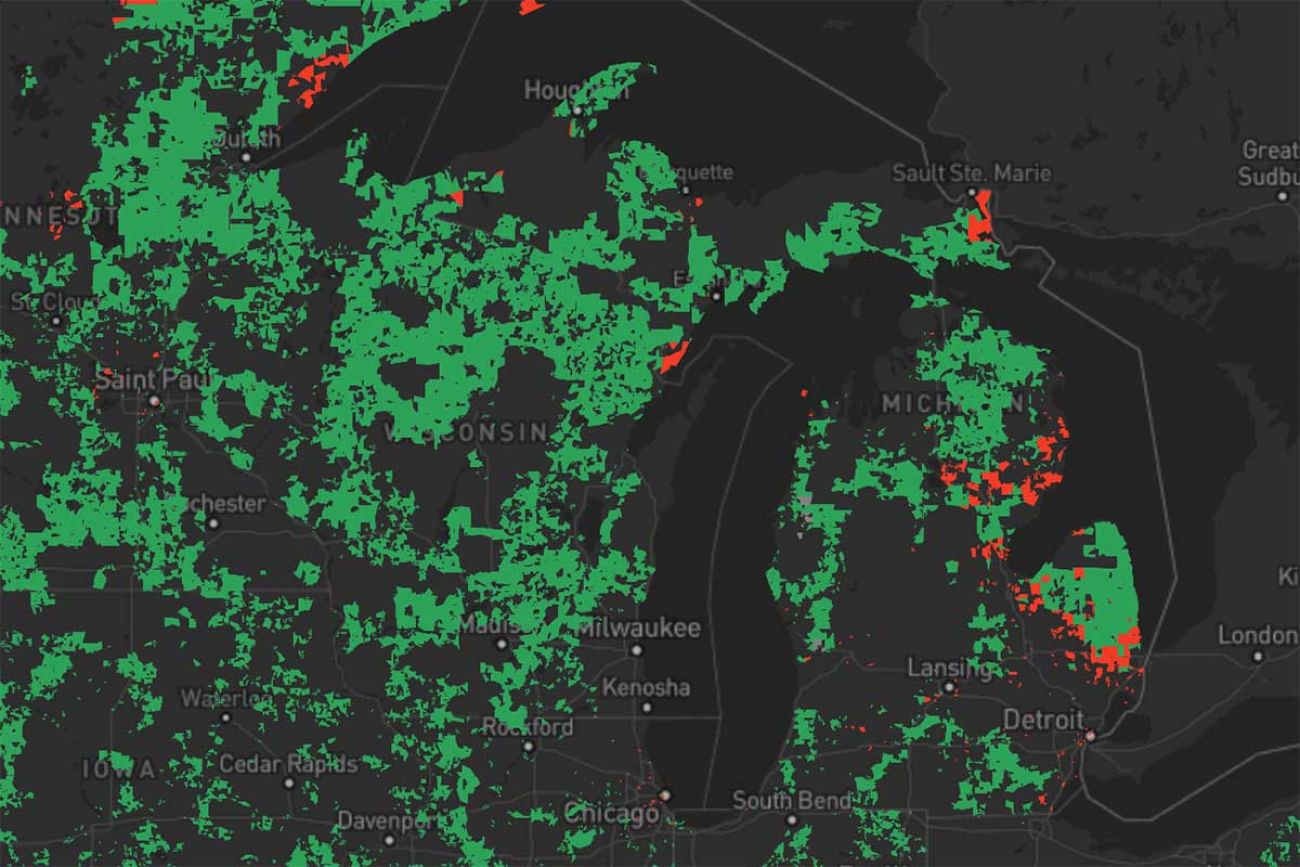COVID reveals Michigan’s internet broadband gap. Will take years to close.

LANSING—When the COVID-19 pandemic closed Michigan school buildings last March and sent students home for remote learning, Amy Zicafoose and her two children scrambled to find internet access wherever they could.
Since broadband is not available at their home in rural Jackson County, they did school work from the car in the parking lot of a coffee shop owned by a friend. They submitted papers from the driveway of her daughter’s principal. They went inside a Realtor friend’s office to use his wifi for homework and Zoom calls.
Related:

“Without the kindness of my friends and my children's school, there's no way that we would have been able to successfully survive with our schooling — any of us,” said Zicafoose, who completed a master’s degree in social work from Michigan State University during the pandemic while navigating life as a single mom with a high school son and a non-verbal autistic daughter.
“I don’t know how I did it.”
Zicafoose’s home in Liberty Township, about a dozen miles south of Jackson, is one of 1.2 million total — or 1 in 4 statewide — that lack a permanent fixed broadband connection, according to Gov. Gretchen Whitmer’s administration. It estimates that connecting all areas of the state could stimulate up to $2.7 billion per year in economic activity.
In Michigan, internet connectivity rates are below the national average in 70 of 83 counties, according to the Brookings Institution, a Washington D.C. think tank. The problem is acute in not only rural counties such as Lake and Missaukee but urban ones including Bay and Wayne.
The so-called broadband gap is driven primarily by availability and affordability. Each poses unique challenges for policy makers who are now rushing to fix a longstanding problem that impacts everything from classroom instruction to doctor’s appointments and church services shifted online.
"It took a pandemic to get everyone to realize how absolutely critical (broadband) is," said Eric Frederick, executive director of Connected Nation Michigan, a nonprofit working with a new state task force to address the broadband gap.
"It's more than just Netflix. In the last year, we saw a huge increase in the need for virtual learning, for teleworking and for telemedicine.”

In rural Michigan, many homes — like the Zicafoose’s — are not wired for broadband because private providers don’t want to invest in costly infrastructure to gain a few customers, Frederick said. In some cities, the issue is often that broadband is simply too expensive for many customers.
Both the state and federal governments are trying to change those dynamics by subsidizing broadband providers, offering grants to encourage private investment in underserved areas and at least temporarily cutting costs for low-income residents during the pandemic.
The Michigan Senate recently approved a bill that would offer tax breaks to service providers. In Congress, U.S. Rep. John Moolenaar, R-Midland, proposes a $300 refundable tax credit for homes that purchase mobile hotspots or signal booster equipment to extend internet service.
But despite a flurry of new bills, programs and emerging technologies, experts say the gap will take years to close and will persist well beyond COVID-19.
"People are slowly starting to think longer term," said Johannes Bauer, director of the Quello Center for Telecommunication Management and Law at Michigan State University.
"The pandemic may not completely go away, at least not quickly,” Bauer said and, even when it does, remote connectivity is now expected in many walks of life.
Whitmer in October announced $12.7 million in grants to internet providers for 10 regional expansion programs in underserved areas spanning 17 Michigan counties. The first round is expected to extend access to more than 10,900 households, businesses and community institutions.
And in the first phase of a massive new subsidy program, the Federal Communications Commission in December promised $9.2 billion to internet providers nationally, including $363 million for 13 firms to expand service in Michigan to nearly 250,000 sites in 81 counties, many at gigabit speeds.
“That’s the biggest investment the FCC has ever made in broadband, and Michigan fared pretty well in that auction," Frederick said. Still, "we're talking about not being able to see the impact of those connections fully for another six years, which is a long time."

Essential, much like heat and water
The new funding doesn’t address another glaring challenge: In many wired parts of the state, including cities small and large, many residents cannot afford the service, said Amanda Bright McClanahan, chief operating officer of the Michigan Economic Development Corporation, a quasi-governmental agency that leads the state's job creation efforts.
"It's one thing to have the pipe, but if you can't even turn it on, it's not solving the problem," she said, arguing broadband access is "just as essential now as heat or electricity or water.”
Data shows the digital divide disproportionally affects students in Michigan's poorest school districts, including those in both rural and urban areas where affordability is often a deciding factor.
Service is widely available in Detroit, for instance, but as of 2017, as many as 40 percent of city residents did not have a connection in their home, according to Data Driven Detroit. Monthly subscription costs can top $80, but some providers are offering steep discounts for low-income families.
Roughly 35 percent of Detroit students did not have access to home internet as of 2018, according to The Education Trust-Midwest, a student advocacy group. In Flint, about 37 percent of students did not have digital access.
The latest federal COVID-19 relief package included $3.2 billion for an Emergency Broadband Benefit program to temporarily cut internet costs by $50 a month for low-income families and $75 a month for those living on tribal lands.
But the program expires six months after the health emergency ends. Advocates hope President Joe Biden will seek more funding to make it permanent, either through an upcoming infrastructure proposal or another avenue.
"Government is a little bit like an elephant on roller skates: It takes a little bit for it to shift, and I think in a lot of ways we’re playing catch up,” said McClanahan of the MEDC.
Schools, in particular, have scrambled to implement stop-gap measures during the pandemic. Some have turned buses into mobile hotspots, used federal relief funds to purchase equipment for students or offered always-on wireless access from their parking lots.
In Detroit, the state's largest city, a coalition of foundations and businesses gave the public school district $23 million last spring to provide families with free laptops and internet service, which the district plans to continue offering through at least June, said spokesperson Chrystal Wilson.
When the state first ordered schools to close their buildings in March, Hartford Public Schools Superintendent Andrew Hubbard said he knew his district was simply not ready for remote learning.
Many of his students live in “extremely rural” parts of Van Buren County that aren’t wired for broadband, Hubbard said. And others from low-income households could not afford computers, let alone internet, he added, noting that more than 80 percent of local students qualify for free and reduced lunches.
So while many Michigan districts pivoted to virtual classes, Hartford went “100 percent packets,” Hubbard said.
Teachers prepared paper-based lessons and assignments for students. The district used buses to deliver and pick up packets, but they were unable to reach all students, so staff would hand-deliver them instead.
“We spent a ton of time — building principals, paraprofessionals, secretaries — driving all around town in the surrounding communities and banging on doors to try to get the packets back to the kids,” Hubbard said. “And unfortunately, we were still doing that this year, but only for our kindergarten through third grade students, up until we returned to face-to-face (classes) Jan. 18.”
Before resuming in-person instruction, Hartford used federal COVID-19 relief funding to buy laptops and wireless hotspots for students. But poor reception in many areas slowed connectivity, as did having more than one child in the same household using a hotspot simultaneously, Hubbard said.
Students had internet access for basic tasks, but when teachers started using video instruction, “that’s when issues became noticeable,” Hubbard said. “Screens would freeze up and students would get kicked out of meetings.”
“There's definitely areas in Michigan where children were drastically more impacted than others by these closures and shutdowns just because of the lack of broadband service,” he said.
“Unfortunately, our community is one of them.”
The rural divide
Michigan is “in the middle of the pack” nationwide when it comes to broadband availability, but it is in the bottom third of the states that subscribe to service, said Frederick of Connected Nation Michigan, the nonprofit working with the state.
The federal government defines broadband as a connection with download speeds of at least 25 megabytes per second downloads and upload speeds of at least 3 Mbps.
In Michigan, more than 212,000 households can’t get those speeds from cable, DSL, fiber or fixed wireless, according to Connected Nation Michigan. Some 55,000 homes can’t get slower speeds of 10 Mbps download and 1 Mbps upload.
The availability gap is much wider in some parts of the state, particularly rural regions.
In Luce County, a low-population area in the Upper Peninsula, most households have access to some form of slow internet service, but less than 2 percent have speeds meeting the federal standard for broadband, according to federal reports.
In rural counties in the Lower Peninsula like Lake, Missaukee and Osceola, less than 50 percent of homes are capable of broadband speeds.
In some cases, the digital divide is maddeningly narrow.
Zicafoose learned she lives less than a half mile away from the nearest broadband cables in rural Jackson County, but she said an internet provider wanted $5,000 to build out to her home.
She declined, and when the pandemic hit, she signed up for satellite internet instead. Zicafoose said she regrets the decision because she pays $80 a month for limited data and speeds that “don’t support one person on Zoom, let alone three.”
The rural divide is personal for state Sen. Aric Nesbitt, R-Lawton, who represents Hartford and other parts of southwest Michigan. His parents, who are farmers, only recently got access to high-speed internet when the local energy cooperative, Midwest Energy, extended broadband wiring to their home.
“They would have had it years before if we didn’t have so many barriers,” said Nesbitt, who is the lead sponsor on legislation that would use tax incentives to encourage providers to extend broadband access into areas with no or extremely slow internet connections.
Under his proposal, an internet provider that builds infrastructure out into those areas would not have to pay personal property taxes on their new equipment for 10 years, making expansion a more cost effective option for smaller companies that typically serve rural regions.
Nesbitt has proposed similar legislation in past years, but the pandemic has spurred new interest in the idea.
His bill cleared the Michigan Senate last week despite blanket opposition from Democrats who say the proposal could hurt local governments and school districts it purports to help by denying them additional property tax revenue that they rely on for basic operations.
“It seems a little counter productive,” Sen. Winnie Brinks, D-Grand Rapids, who agreed that access is important but added the incentive plan could have unintended consequences for schools.
Democrats also argue Nesbitt’s bill wouldn’t do anything to help low-income residents who simply can’t afford service.
That’s a separate issue, he said, noting that several internet service providers offer steep discounts to low-income families and have voluntarily sweetened those deals during the pandemic.
Comcast, for instance, offers households eligible for public assistance programs an Internet Essentials option for $9.95 per month. The first two months are now free, through June, and the company recently doubled download speeds at no additional cost, according to a spokesperson.
“There's a difference between having it go by your doorstep and not being able to afford it, and not even having it come by your doorstep,” Nesbitt said. “Let’s go full bore to try to get the state connected.”
A sense of urgency
Huge swaths of northern Michigan and the Upper Peninsula lack the infrastructure necessary for widespread broadband access. But availability is not just a northern issue: There are pockets of limited connectivity in areas like Oakland and Macomb counties, and there is a "very distinct ring" in rural regions outside Lansing, the state's capital city, Frederick said.
His nonprofit, Connected Nation Michigan, is contracted with the state to help steer a 12-agency task force charged with developing strategies to expand broadband accessibility and affordability. They’re building on a connectivity “road map” developed under former Gov. Rick Snyder.
The Michigan Economic Development Corporation, which is leading the task force, decided about a year ago to put its full "oomph" behind the effort to ensure fast and affordable broadband "in every corner of the state," the group’s COO, McClanahan, told Bridge Michigan.
The broadband gap is an economic issue because it’s “a limiter for talent attraction and talent retention," McClanahan said. "It is a limiter as communities are trying to attract businesses. It is a limiter as communities are trying to access education during the pandemic.”
Officials have pursued some innovative public-private partnerships in the past that could be models moving forward, she said.
Northern Michigan University, for instance, got federal approval to extend its high-speed LTE wireless network into communities across the Upper Peninsula and now provides internet access to roughly 18,000 homes, including 7,500 paying customers with no direct connection to the college.
Still, the broadband gap in parts of the Upper Peninsula remains huge.
Nesbitt's proposal could help spur additional investment in rural areas, Frederick said, but it would likely impact only a small number of households in the “most unserved parts of the state” and threatens to siphon tax revenue from cities that are “already strapped.”
“I'm hopeful for it if it passes, because I think it could be a useful tool, but I just hope that both sides of that equation are considered,” he said, referencing municipal finances.
New technologies like 5G wireless and SpaceX satellites hold some promise for areas that still lack high-speed internet, said Bauer, the Michigan State University researcher.
But both will require huge investments by private companies, and rural areas may be among the last to benefit from 5G, so fiberoptic remains the most “scalable” option, even if it could also take years to build out.
“The pandemic created a high sense of urgency — we want to have these things fixed now and immediately — but that unfortunately was not possible for all the people,” Bauer said. “A lot of folks were more disadvantaged in the pandemic than before."
See what new members are saying about why they donated to Bridge Michigan:
- “In order for this information to be accurate and unbiased it must be underwritten by its readers, not by special interests.” - Larry S.
- “Not many other media sources report on the topics Bridge does.” - Susan B.
- “Your journalism is outstanding and rare these days.” - Mark S.
If you want to ensure the future of nonpartisan, nonprofit Michigan journalism, please become a member today. You, too, will be asked why you donated and maybe we'll feature your quote next time!




